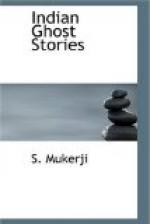There were some people living in the two-storied houses in the neighbourhood. The brickbats and the bones must have come from there. As a matter of fact the police discovered that the Boarding House students and the people who lived in these houses were not on good terms. Those people had organized a music party and the students had objected to it. The matter had been reported to the Magistrate and had ended in a decision in favour of the students. Hence the strained relations. This was the most natural explanation and the only explanation. But this explanation did not satisfy me for several reasons.
The first reason was that the college compound contained another well kept lawn that stood between the Hostel buildings and those two-storied houses. There were no brickbats on this lawn. If brickbats had been thrown from those houses some at least would have fallen upon the lawn.
Then as regarded the brickbats that were in the room, they had all dropped from the ceiling; but in the morning we found the tiles of the roof intact. Thirdly, in the middle of the central lawn there was at least one whole brick. The nearest building from which a brick might have been thrown was at a distance of 100 yards and to throw a whole brick 9"x41/2"x3” such a distance would require a machine of some kind or other and none was found in the house.
The last thing that created doubts in my mind was this that not one brickbat had hit anybody. There were so many of us there and there was such an abundance of brickbats still not one of us was hit, and it is well known that brickbats hurled by Ghostly hands do not hit anybody. In fact the whole brick that came and stood on edge within 3 inches of my toe would have hurt me if it had only toppled over.
* * * * *
It is known to most of the readers that Sutteeism was the practice of burning the widows on the funeral pyre of their dead husbands. This practice was prevalent in Bengal down to the year 1828 when a law forbidding the aiding and abetting of Sutteeism was passed. Before the Act, of course, many women were, in a way, forced to become Suttees. The public opinion against a widow’s surviving was so great that she preferred to die rather than live after her husband’s death.
The law has, however, changed the custom and the public opinion too.
Still, every now and then there are found cases of determined Sutteeism among all classes in India who profess Hinduism. Frequent instances are found in Bengal; and whenever a case comes to the notice of the public the newspapers report it in a manner which shows that respect for the Suttee is not yet dead.
Sometimes a verdict of “Suicide during temporary insanity” is returned, but, of course, whoever reads the report understands how matters stand.
I know of a recent case in which a gentleman who was in Government service died leaving a young widow.




